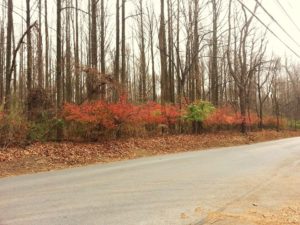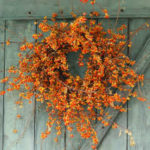Fall in the mid-Atlantic is a beautiful time of year. We’re fortunate to have moderate temperatures before winter strikes, resulting in the rich, fiery hues of autumn foliage. Fall color is so important, it is considered in all good designs equally as much as spring flowers and winter interest. All fall color isn’t created equal though and we’ll discuss why some plants are better choices for the landscape than others.
Avoiding Invasive Species

The best way to avoid invasive species is to intentionally select native plant species. There are more than a few invasives that may be tempting to purchase for fall interest, but beware; those attractive plants come at a cost to our ecosystem. In fact, the United States spends nearly $120 billion on damages from invasive species annually1. Burning Bush, Maiden Grass, and Oriental Bittersweet are some of the common temptations you should avoid.
Many of the species now considered invasive, started out as ornamental plants in the landscape industry. Burning Bush or Winged Euonymus (Euonymus alatus) is one that isn’t particularly showy most of the year, but its fire-truck red foliage in fall has made it a landscape favorite on the east coast for the past 150 years.
Unfortunately, this plant has escaped the landscape through the spread of its seed. It has so successfully taken over woodlands, that it is now illegal to buy, import, or plant in Massachusetts2 and New Hampshire3. Over the next few weeks, pay attention to the understory plants in many local woodlands; you are sure to see the iconic red color of Burning Bush clearly crowding out our native understory species.
Other plants such as Maiden Grass (Miscanthus sinensis) and Oriental Bittersweet (Celastrus orbiculatus) are also invasive species that have traditionally been valued for their interesting fall textures as well as their color. Maiden Grass develops feathery seed heads atop large mounds of ornamental grass foliage. Oriental Bittersweet (left) is a vine commonly found taking over our woodlands. In fall, Bittersweet is collected and sold for wreaths and displays when its seeds open up to display red seeds within its yellow capsule.
Both Maiden Grass and Oriental Bittersweet are very pretty when used in fall displays, but their invasive habit should be reason enough to avoid them. Fortunately, there are very many native plants that can provide fall color and texture, as well as provide habitat for local wildlife.
Selecting Native Species
There are so many wonderful native plants that provide color and ecological benefits well into the fall. Whether you have sun or shade; wet soil or dry; acres or just a balcony, there are native species that can help you get into the fall spirit and help the local ecosystem. Fothergilla, Little Bluestem, and Aster are just a few of our favorites for fall.
A shrub to rival and outcompete any plant for vibrant fall foliage is our native Fothergilla (Fothergilla sp.). Available in both a dwarf variety and a tall variety, Fothergilla (below, left) fits in just about any landscape. Early spring white “bottlebrush” flowers give way to attractive foliage in summer. By fall, Fothergilla seems to glow from the inside with foliage in shades of yellow, orange, red, and purple.
Little Bluestem (Schizachyrium scoparium) is a gorgeous native warm-season grass used in meadows and gardens alike. The cultivar ‘Standing Ovation’ (below, center) is particularly attractive in the garden because its stems remain upright through the fall. Although the seed heads may be less showy than other ornamental grasses, the leaves of Little Blue stem change from their dusty blue summer color to rich shades of burgundy.
Some of us prefer to do a little extra primping to our homes to celebrate fall. In addition to Indian corn, gourds, and straw bales, native asters make a great addition to the garden and containers. ‘Purple Dome’ New England Aster is commonly available at most local garden centers. Its dark purple flowers compliment the traditional yellows and oranges we see this time of year. A GreenWeaver favorite is ‘October Skies’ Aromatic Aster (below, right) which blooms later than most perennials, making it also a favorite of pollinators looking for a late season treat. It has lavender-blue flowers that pops in the garden.
There is no shortage of vibrant colors and rich textures to use for a native fall landscape. Try some of the plants described above, or check out some of these additional favorites:
Trees:
- Sugar Maple (Acer saccharum)
- Sourwood (Oxydendrum arboreum)
- Black Gum (Nyssa sylvatica)
Shrubs:
- Oakleaf Hydrangea (Hydrangea quercifolia)
- Smooth Witherrod (Viburnum nudum)
- Red Chokeberry (Aronia arbutifolia)
Vines:
- Virginia Creeper (Parthenocissus quinquefolia)
Grasses and Perennials:
- Broomsedge (Andropogon virginicus)
- Goldenrod species (Solidago sp.)
- Bluestar (Amsonia sp.)



